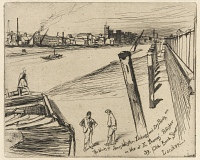Etchings Institutions search term: mclean
Millbank | ||
| Number: | 78 | |
| Date: | 1861 | |
| Medium: | etching and drypoint | |
| Size: | 102 x 127 mm | |
| Signed: | 'James Whistler' (in inscription) (1-4); removed (5) | |
| Inscribed: | '1861' at lower left; 'The Works of James Whistler: Etchings and Dry Points, are on View at E. Thomas' .. Publisher / 39. Old Bond Street' at lower right (1-2); 'London.' added (4); erased (5) | |
| Set/Publication: | 'Thames Set', 1871 | |
| No. of States: | 5 | |
| Known impressions: | 67 | |
| Catalogues: | K.71; M.71; T.44; W.67 | |
| Impressions taken from this plate (67) | ||
KEYWORD
TITLE
'Millbank' (1871, Ellis & Green). 3
'View taken at Vauxhall' (1874, Ralph Thomas, Jr (1840-1876)). 4
'Millbank' (1886, Frederick Wedmore (1844-1921)). 5
All later cataloguers agreed on 'Millbank', the title of the etching when first published in the 'Thames Set' in 1871.
3: A Series of Sixteen Etchings of Scenes on the Thames.
4: Thomas 1874 , (cat. no. 44).
5: Wedmore 1886 A , (cat. no. 67).
DESCRIPTION
SITE
The erection of a bridge at Lambeth was authorised by Act of Parliament in 1860. Thus Whistler, in 1861, was recording a view that would be radically changed when the new bridge was completed, for Lambeth Palace would be partly obscured from Millbank. Designed by Peter W. Barlow, Lambeth suspension bridge opened in 1862. 8 The bridge proved insufficiently secure for its purpose, and became a pedestrian bridge, but was eventually closed. The current bridge, designed by the engineer Sir George Humphreys and architect Sir Reginald Blomfield, was opened in 1932.
6: Thomas 1874 , (cat. no. 44).
7: [Ellis, Frederick Startridge], Memories of Men, Places and Things, belonging to past times, London , n.d. [1896/1897], p. 52.
8: 'Lambeth Suspension Bridge, The Times (London), 11 November 1862, p. 5.
DISCUSSION
9: Lochnan 1984 , p. 126.
